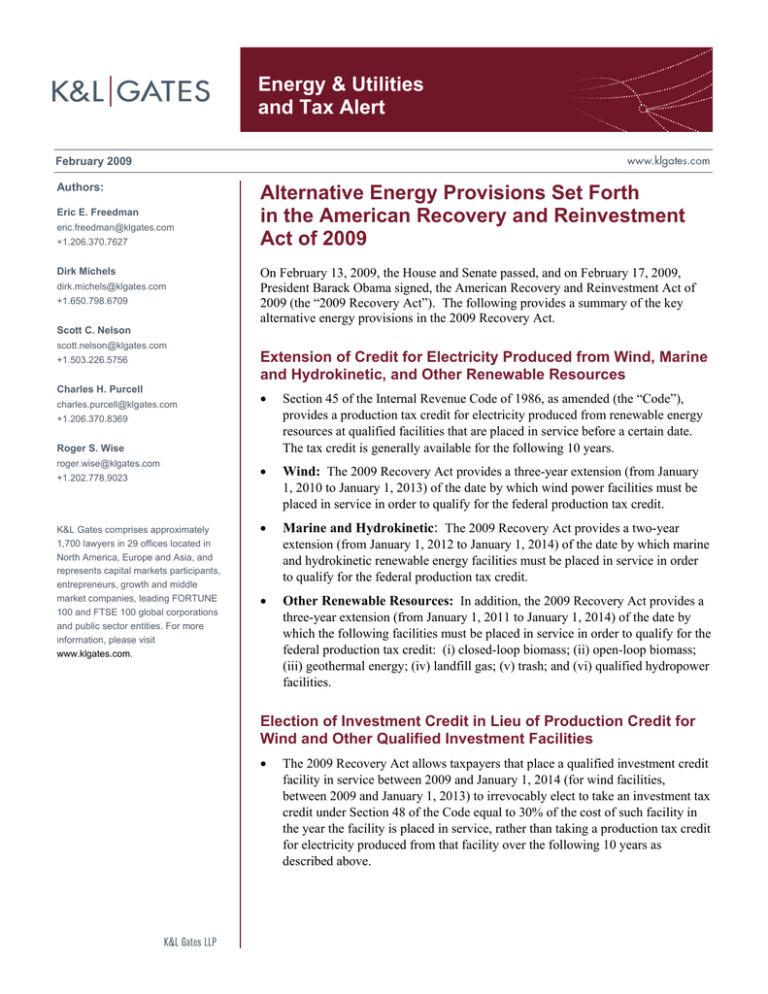
Energy & Utilities
and Tax Alert
February 2009
Authors:
Eric E. Freedman
eric.freedman@klgates.com
+1.206.370.7627
Dirk Michels
dirk.michels@klgates.com
+1.650.798.6709
Scott C. Nelson
scott.nelson@klgates.com
+1.503.226.5756
Charles H. Purcell
charles.purcell@klgates.com
Alternative Energy Provisions Set Forth
in the American Recovery and Reinvestment
Act of 2009
On February 13, 2009, the House and Senate passed, and on February 17, 2009,
President Barack Obama signed, the American Recovery and Reinvestment Act of
2009 (the “2009 Recovery Act”). The following provides a summary of the key
alternative energy provisions in the 2009 Recovery Act.
Extension of Credit for Electricity Produced from Wind, Marine
and Hydrokinetic, and Other Renewable Resources
•
Section 45 of the Internal Revenue Code of 1986, as amended (the “Code”),
provides a production tax credit for electricity produced from renewable energy
resources at qualified facilities that are placed in service before a certain date.
The tax credit is generally available for the following 10 years.
•
Wind: The 2009 Recovery Act provides a three-year extension (from January
1, 2010 to January 1, 2013) of the date by which wind power facilities must be
placed in service in order to qualify for the federal production tax credit.
•
Marine and Hydrokinetic: The 2009 Recovery Act provides a two-year
extension (from January 1, 2012 to January 1, 2014) of the date by which marine
and hydrokinetic renewable energy facilities must be placed in service in order
to qualify for the federal production tax credit.
•
Other Renewable Resources: In addition, the 2009 Recovery Act provides a
three-year extension (from January 1, 2011 to January 1, 2014) of the date by
which the following facilities must be placed in service in order to qualify for the
federal production tax credit: (i) closed-loop biomass; (ii) open-loop biomass;
(iii) geothermal energy; (iv) landfill gas; (v) trash; and (vi) qualified hydropower
facilities.
+1.206.370.8369
Roger S. Wise
roger.wise@klgates.com
+1.202.778.9023
K&L Gates comprises approximately
1,700 lawyers in 29 offices located in
North America, Europe and Asia, and
represents capital markets participants,
entrepreneurs, growth and middle
market companies, leading FORTUNE
100 and FTSE 100 global corporations
and public sector entities. For more
information, please visit
www.klgates.com.
Election of Investment Credit in Lieu of Production Credit for
Wind and Other Qualified Investment Facilities
•
The 2009 Recovery Act allows taxpayers that place a qualified investment credit
facility in service between 2009 and January 1, 2014 (for wind facilities,
between 2009 and January 1, 2013) to irrevocably elect to take an investment tax
credit under Section 48 of the Code equal to 30% of the cost of such facility in
the year the facility is placed in service, rather than taking a production tax credit
for electricity produced from that facility over the following 10 years as
described above.
Energy & Utilities and Tax Alert
•
For this purpose, qualified investment credit
facilities include facilities otherwise eligible for
the production tax credit (i.e., wind facilities,
closed-loop biomass facilities, open-loop
biomass facilities, geothermal energy facilities,
landfill gas facilities, trash facilities, qualified
hydropower facilities, and marine and
hydrokinetic renewable energy facilities).
Qualified investment facilities do not include
refined coal, Indian coal, or solar facilities.
of the Code and the qualifying gasification
project credit under Section 48B of the Code.
Grants for Wind, Solar, and Certain
Other Renewable Energy Properties in
Lieu of Investment Credit or
Production Tax Credit
•
Section 1603 of the 2009 Recovery Act
provides that taxpayers may apply to the
Treasury Secretary for a grant when they place
specified energy property (i.e., an electricity
production facility otherwise eligible for the
production tax credit under Section 45 of the
Code or qualifying property otherwise eligible
for the investment tax credit under Section 48
of the Code) in service.
•
The grant amount is between 10% and 30% of
the energy property basis and may be capped at
a set amount per Kw nameplate capacity for
certain properties.
•
The grant is in lieu of investment tax credits or
production tax credits in respect of such
facilities and may be recaptured if (i) the
taxpayer disposes of the property for which the
grant was made or (ii) the property for which
the grant was made ceases to be specified
energy property.
•
In order to receive a grant, the property must be
placed in service during 2009 or 2010 or
construction of the property must have
commenced during 2009 or 2010 and the
property must be placed in service before the
applicable credit termination date.
•
Taxpayers must meet specific requirements
(e.g., application filing deadline, placed in
service dates, and the requirements under
Sections 45, 48, and 50 of the Code) in order to
receive a grant under Section 1603 of the 2009
Recovery Act. For a more detailed discussion
of these grants and the requirements thereof,
please see; Grants in Lieu of Investment Tax
Credit or Production Tax Credit, Energy &
Utilities and Tax Alert, by Eric E. Freedman,
Dirk Michels, Charles H. Purcell and Roger S.
Wise, February 2009.
Qualified Small Wind Energy Property
•
Section 48 of the Code provides a
nonrefundable investment tax credit equal to
30% of the basis of each “qualified small wind
energy property” placed in service during the tax
year. Qualified small wind energy property is
property that uses a qualifying small wind
turbine (i.e., a wind turbine with a nameplate
capacity of not more than 100 kilowatts) to
generate electricity and that is placed in service
between December 31, 2008 and December 31,
2016. The 2009 Recovery Act eliminates the
cap of $4,000 per taxpayer that had previously
applied to credits claimed with respect to
qualified small wind energy property.
Elimination of Basis Reduction for
Projects Financed with Subsidized
Energy Financing and Private Activity
Bonds (§ 1103 of the 2009 Recovery
Act)
•
•
Under the 2009 Recovery Act, basis in solar,
wind, and certain other renewable energy
properties is no longer reduced for purposes of
claiming the investment tax credit under Section
48 of the Code if the property is financed in
whole or in part by subsidized energy financing
or with proceeds from private activity bonds.
The special basis reduction rule for property
financed by subsidized energy financing or
private activity bonds continues to apply,
however, for purposes of the qualifying
advanced coal project credit under Section 48A
February 2009
2
Energy & Utilities and Tax Alert
•
These grants are intended to provide an
alternative mechanism for project owners to
finance certain renewable energy projects under
current market conditions where financing may
not otherwise be available and to allow project
owners that may have less taxable income than
necessary to fully benefit from the credits under
Sections 45 and 48 of the Code to recover the
costs of energy facilities.
holder to a nonrefundable credit on specified
dates during the year. The 2009 Recovery Act
increases the national energy conservation bond
limitation from $800 million to $3.2 billion,
meaning that an additional $2.4 billion of
national energy conservation bonds may be
issued each year. For a more detailed
discussion of the provisions in the 2009
Recovery Act relating to tax credit bonds,
please see; Potential Impacts of the Federal
Stimulus Legislation on Municipal Bond
Issuers, Public Finance Alert, by Edward A.
McCullough, Jennifer B. Cordova, February
17, 2009.
Increased Allocations of New Clean
Renewable Energy Bonds and
Qualified Energy Conservation Bonds
•
The 2009 Recovery Act increases the national
bond volume limitation for clean renewable
energy bonds -- a type of qualified tax credit
bond -- by $1.6 billion.
Increased Limitation on Issuance of
Qualified Energy Conservation Bonds
•
A qualified energy conservation bond is another
type of qualified tax credit bond that entitles a
•
The 2009 Recovery Act creates a new
investment credit -- the qualifying energy
project credit -- under Section 46 of the Code.
For a detailed description of this credit please
see; The Qualifying Energy Credit under the
2009 Recovery Act, Energy & Utilities and Tax
Alert, by Eric E. Freedman, Dirk Michels,
Charles H. Purcell and Roger S. Wise, February
2009.
K&L Gates comprises multiple affiliated partnerships: a limited liability partnership with the full name K&L Gates LLP qualified in Delaware and
maintaining offices throughout the U.S., in Berlin and Frankfurt, Germany, in Beijing (K&L Gates LLP Beijing Representative Office), and in
Shanghai (K&L Gates LLP Shanghai Representative Office); a limited liability partnership (also named K&L Gates LLP) incorporated in England and
maintaining our London and Paris offices; a Taiwan general partnership (K&L Gates) which practices from our Taipei office; and a Hong Kong
general partnership (K&L Gates, Solicitors) which practices from our Hong Kong office. K&L Gates maintains appropriate registrations in the
jurisdictions in which its offices are located. A list of the partners in each entity is available for inspection at any K&L Gates office.
This publication is for informational purposes and does not contain or convey legal advice. The information herein should not be used or relied upon
in regard to any particular facts or circumstances without first consulting a lawyer.
©2009 K&L Gates LLP. All Rights Reserved.
February 2009
3



